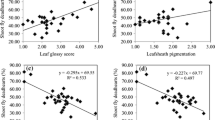Abstract
Sorghum shoot fly, Atherigona soccata is one of the serious constraints to sorghum production, and host plant resistance is an important component for controlling this pest. We studied the expression of resistance to A. soccata in a diverse array of sorghum genotypes in relation to composition of leaf surface chemicals during the seedling stage. The sorghum genotypes IS 1054, IS 1057, IS 2146, IS 4664, IS 2312, IS 2205, SFCR 125, SFCR 151, ICSV 700, and IS 18551 exhibited antixenosis for oviposition, and suffered less deadhearts due to sorghum shoot fly, A. soccata. Compounds undecane 5- methyl, decane 4- methyl, hexane 2, 4- methyl, pentadecane 8- hexyl, and dodecane 2, 6, 11- trimethyl, present on the leaf surface of sorghum seedlings, were associated with susceptibility to shoot fly; while 4, 4- dimethyl cyclooctene was associated with resistance to shoot fly. The compounds associated with resistance/susceptibility to shoot fly, can be used as marker traits to select for resistance as well as for diversifying and increasing the levels of resistance to this pest. The role of biochemical compounds for developing sorghum varieties with resistance to shoot fly, A. soccata has been discussed.
Similar content being viewed by others
Abbreviations
- GC-MS:
-
Gas chromatography-mass spectrometry
- CRD:
-
Completely randomized design
- DAE:
-
Days after seedling emergence
- ICSV:
-
ICRISAT sorghum variety
- LSD:
-
Least significant difference
- RCBD:
-
Randomized complete block design
- ANOVA:
-
Analysis of variance
- SAT:
-
Semi arid tropics
References
Bate NJ, Rothstein SJ (1998) C6 volatiles derived from the lipoxygenase pathway induce a subset of defense-related genes. Plant J 16:561–569
Beck SD (1965) Resistance of plants to insects. Ann Rev Entomol 10:207–232
Chamarthi SK, Sharma HC, Lakshmi Narasu M, Pampapathy G (2008) Mechanisms and diversity of resistance to shoot fly, Atherigona soccata in Sorghum bicolor. Indian J Plant Prot 36:249–256
Chamarthi SK, Sharma HC, Sahrawat KL, Narasu LM, Dhillon MK (2010) Physico-chemical mechanisms of resistance to shoot fly, Atherigona soccata in sorghum, Sorghum bicolor. J Appl Entomol. doi:10.1111/j.1439-0418.2010.01564.x
Dhillon MK, Sharma HC, Singh R, Naresh JS (2005) Mechanisms of resistance to shoot fly, Atherigona soccata in sorghum. Euphytica 144:301–312
Doggett H, Starks KJ, Eberhart SA (1970) Breeding for resistance to the sorghum shoot fly. Crop Sci 10:528–531
Hatanaka A (1993) The biogeneration of green odor by green leaves. Phytochemistry 34:1201–1218
ICRISAT (1992) The medium term plan, volume 2. International Crops Research Institute for the Semi-Arid Tropics (ICRISAT), Patancheru
Lo SCC, De Verdier K, Nicholson RL (1999) Accumulation of 3-deoxyanthocyanidin phytoalexins and resistance to Colletotricum sublineolum in sorghum. Physiol Mol Pl Pathol 55:263–273
Nwanze KF, Sree PS, Butler DR, Reddy DDR, Reddy YVR, Soman P (1990) The dynamics of leaf surface wetness of sorghum seedlings in relation to resistance to the shoot fly, Atherigona soccata. Entomol Exp Applic 64:151–160
Nwanze KF, Pring RJ, Sree PS, Butler DR, Reddy YVR, Soman P (1992) Resistance in sorghum to the shoot fly, Atherigona soccata: epicuticular wax and wetness of the central whorl leaf of young seedlings. Ann Appl Biol 120:373–382
Nwanze KF, Nwilene FE, Reddy YVR (1998) Evidence of shoot fly, Atherigona soccata Rondani (Diptera muscidae) oviposition response to sorghum seedlings volatiles. J Appl Entomol 122:591–594
Ogwaro K (1978) Ovipositional behavior and host-plant preference of the sorghum shoot fly, Atherigona soccata (Diptera: Anthomyiidae). Entomol Exp Applic 23:189–199
Painter RH (1958) Resistance of plants to insects. Ann Rev Entomol 3:267–290
Pare PW, Tumlinson JH (1996) Plant volatile signals in response to herbivore feeding. Fla Entomol 79:93–103
Raina AK, Thindwa HZ, Othieno SM, Corkhill RT (1981) Resistance in sorghum to sorghum shoot fly: larval development and adult longevity and fecundity on selected cultivars. Insect Sci Applic 2:99–103
Robert JH, Glenn WC, Samuel DS, Joseph DN, William RO, James AR (1992) Comparison of the volatile compounds from several commercial plum cultivars. J Sci Fd Agric 60:21–23
Schoonhoven LM (1968) Chemosensory basis of host plant selection. Ann Rev Entomol 13:115–136
Sharma HC, Nwanze KF (1997) Mechanisms of resistance to insects and their usefulness in sorghum improvement. Information Bulletin no: 55. International Crops Research Institute for the Semi-Arid Tropics (ICRISAT), Patancheru, p 51
Sharma HC, Taneja SL, Leuschner K, Nwanze KF (1992) Techniques to screen sorghums for resistance to insect pests. Information Bulletin No 32. International Crops Research Institute for the Semi-Arid Tropics, Patancheru 502 324, Andhra Pradesh, India, pp 48
Sharma HC, Reddy BVS, Dhillon MK, Venkateswaran K, Singh BU, Pampapathy G, Folkertsma RT, Hash CT, Sharma KK (2005) Host plant resistance to insects in sorghum: present status and need for future research. Int Sorghum Millets Newslett 46:36–42
Singh BU, Padmaja PG, Seetharama N (2004) Stability of biochemicals constituents and their relationships with resistance to shoot fly, Atherigona soccata (Rondani) in seedling sorghum. Euphytica 136:279–289
Soto PE (1974) Ovipositional preference and antibiosis in relation to resistance to sorghum shoot fly. J Econ Entomol 67:265–267
Sree PS, Nwanze KF, Butler DR, Reddy DDR, Reddy YVR (1994) Morphological factors of the central whorl leaf associated with leaf surface wetness and resistance in sorghum to shoot fly, Atherigona soccata. Ann Appl Biol 125:467–476
Weir TL, Park SW, Vivanco JM (2004) Biochemical and physiological mechanisms mediated by allelochemicals. Curr Opinion Pl Biol 7:472–479
Weston LA, Nimbal CL, Jeandet P (1999) In: Inderjit KMMD, Foy CL (eds) Allelopathic potential of grain sorghum [Sorghum bicolor (L) Moench] and related species. Principles and practices in plant ecology. Allelochemical interactions. CRC, Florida, pp 467–477
Acknowledgements
The authors are thankful to the staff of entomology for their help in field and greenhouse experiments. We gratefully acknowledge the financial support provided by the Suri Sehgal Foundation to carryout these studies.
Author information
Authors and Affiliations
Corresponding author
Rights and permissions
About this article
Cite this article
Chamarthi, S.K., Sharma, H.C., Vijay, P.M. et al. Leaf surface chemistry of sorghum seedlings influencing expression of resistance to sorghum shoot fly, Atherigona soccata . J. Plant Biochem. Biotechnol. 20, 211–216 (2011). https://doi.org/10.1007/s13562-011-0048-3
Received:
Accepted:
Published:
Issue Date:
DOI: https://doi.org/10.1007/s13562-011-0048-3




